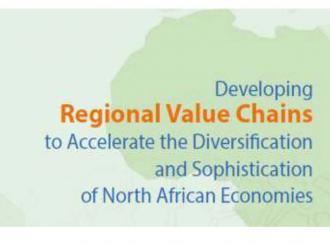
Rabat, 13 November 2014 (ECA) - The integration of developing countries in world trade happens increasingly through their participation in global value chains (GVCs). However access to GVCs involves many prerequisites, including logistics, institutional and legal environment, which require significant investment both in human and finance, and active public policies in this area. Moreover, even when integrated into the GVCs, many developing countries remain confined in the low value added parts of the GVCs, due to technical constraints, but also because of their non-participation in decision-making and strategic dimensions of products distributions through GVCs. The example of the textile industry in some North African countries is a very good illustration. One way to overcome this double constraint for countries in North Africa is to develop cooperatively Regional Value Chains (RVCs) that will create new dynamic comparative advantages and better overcome the inherent constraints of GVCs, and accelerate the strategic diversification and sophistication of their economies.
Indeed, until the 2000s, the North African countries have not implemented appropriate strategies to organize and plan a diversification that has usually remained the result of the efforts of the private sector focused on labor-intensive activities. Indeed, few countries have accompanied these diversification efforts through active public policies, especially in the field of finance, research, access to external markets, or the integration of global value chains. Furthermore, the competitive advantage of the North African countries in terms of cost and labor has gradually eroded with social changes and the strengthening of the middle class resulting in an increase in the cost of labor. This competitive advantage has also weakened due to the liberalization of international trade with the advent of the WTO and the gradual displacement of the center of gravity of the global economy from Europe to East Asia.
In the 2000s, the North African countries, aware of the importance of industrialization for the development of their societies, registered to an industrial modernization process at different levels. Some countries in the region have developed policy instruments which include the development of multisectoral industrial strategies in the medium and long term, as well as the establishment of Special Economic Zones. The different national strategies aimed to place the countries of the region in the process of global industrial production and take advantage of the international value chains.
However, this national based approach is constrained by the size of the economies of the region and their weak capacity to integrate the most profitable segments of GVCs. It also ignores the territorial dimension of development and barely exploits the potential of an integrated approach to development in the North African region. Indeed, the low level of trade integration in North Africa, coupled with the relatively significant infrastructure development, suggests significant potential for development of RVCs.
Therefore, it is necessary to better prioritize different aspects of RVCs in North Africa in order to establish a concrete strategy for the development of RVCs in the region and also between North Africa and its immediate neighbor, West Africa. Many lessons could be learned from other regional experiences on the continent or elsewhere in the world.
A clear diagnosis of the area was developed by the CEA in this regard:
(i) Industrialization is central to fostering effective structural transformation in North Africa,
(ii) the countries of the sub region are only marginally active in world trade, they are hampered by growing structural deficits, in large part as a result of limited diversification of their production systems, and they face many challenges requiring stronger and more sustainable and inclusive growth;
(iii) the participation of countries in world trade increasingly takes place within global value chains and access to these chains involves many prerequisites, particularly in terms of logistics and the institutional and legal environment, which requires significant human, financial and public policy investments;
(iv) regional trade makes up only 4.8 per cent of overall North African trade and the share of manufactured goods in trade flows is falling,
(v) the development of regional value chains can be an important lever for addressing challenges through:
- accelerating the sophistication and diversification of economies,
- promoting the development of new dynamic comparative advantages and,
- facilitating participation in higher added-value segments of global value chains.
By bringing together experts around two events on this issue (expert meeting on 19-20 and academic colloquium on 20-22 November 2014) the ECA North Africa office is to deepen the analysis and promote knowledge generation of to:
- identify the growth sectors in RVCs by “mapping” the strengths and comparative advantages of each country in the sub region and identifying the levers and challenges to be overcome in order to set in motion truly effective regional cooperation;
- adopt a systematic approach that will establish priorities between the various value chains; to identify the various actors and their linkages and interactions; to analyze the technological capabilities and economic performance; and to formulate a strategy for the upgrading of selected value chains, while considering the regulatory and institutional dimensions;
- develop partnerships between ECA and other international and regional organizations in order to improve the availability of statistical information and to increase the real impact of efforts to create and manage knowledge and formulate programmes and projects that will conduct to sustainable positive impact on the transformative agenda that ECA is promoting in the sub-region.
Issued by:
ECA External Communications and Media Relations Section
PO Box 3001
Addis Ababa
Ethiopia
Tel: +251 11 551 5826
E-mail: ecainfo@uneca.org